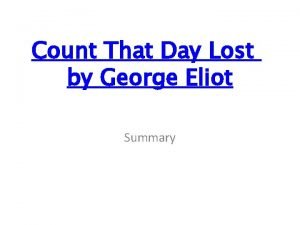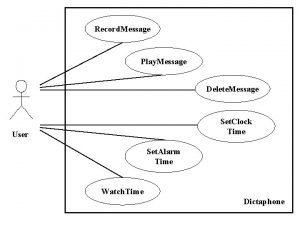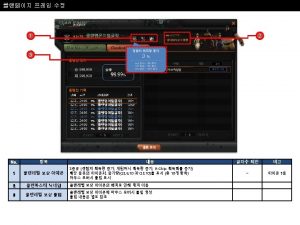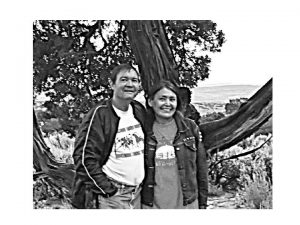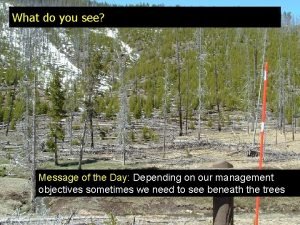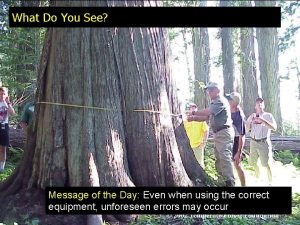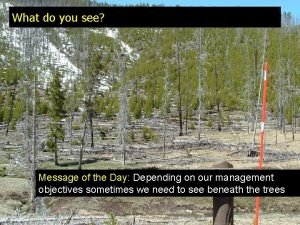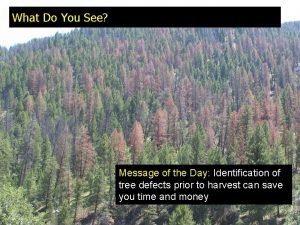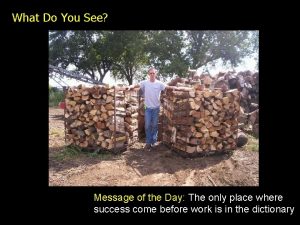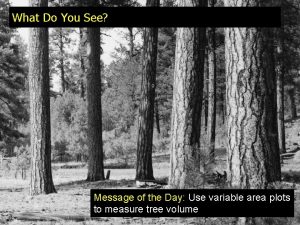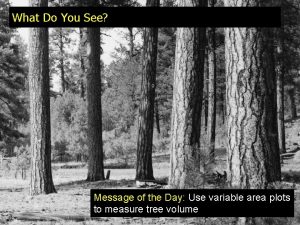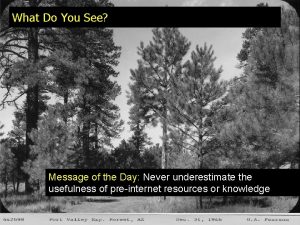What Do You See Message of the Day






































- Slides: 38

What Do You See? Message of the Day: Informed forest management decisions need information about current and projected conditions

FOR 274: Forest Measurements and Inventory Growth, Yield and Biomass • Overview • Growth Percentage • Stand Growth • Tree and Stand Biomass • Allometrics • Modeling Growth and Yield Husch, Beers and Kershaw pp 250 -257, chapters 15 & 16

Growth and Yield: Overview Growth: biological phenomenon of increase in size with time Increment: quantitative increase in size in a specified time interval due to growth Yield: the total amount (of timber) available for harvest

Growth and Yield: Overview Current annual increment: growth within the past year Periodic annual Increment: average growth of a series of years (5 or 10) Mean annual increment: Current (cumulative) size divided by the age

Growth and Yield: Overview Factors affecting growth include: - genetics - climatic factors (temp, precip, wind, etc) - soil factors (moisture, ph, etc) - topography (slope, elevation, aspect) - competition (influence of other trees)

Growth and Yield: Overview To evaluate the usefulness of different treatment options we often use “growth and yield models” to forecast the dynamics of a stand. Stand dynamics: Growth, mortality, reproduction, and other stand changes Growth and yield models produce stand estimates (basal area, volume, trees per acre, etc)

Growth and Yield: Overview Growth Curve: Size plotted against age Sizes Include: • Heights • Volumes • Diameter • Weight

Growth and Yield: Overview Growth Curve: S- (or sigmoid) shaped and shows cumulative growth at any age Height Age

Growth and Yield: Overview Rate of Growth Curve: Rapid growth in youth with decreasing rate as tree matures Rate Age

Growth and Yield: Overview Current and mean annual growth curves: DBH Growth Age

Growth and Yield: Growth Percentage A measure of the average rate of change in size or volume over a given time interval Growth percent = 100 * (V 2 -V 1)/(N*V 1) V 1 = Volume or size at start V 2 = Volume or size at end N = number of years This measure is analogous to interest rates as found in economics

Stand Growth: Overview The fundamental components of stand growth are: • Accretion – growth of all the trees as measured at the start of the growth period • Mortality – Volume of trees initially measured that died and not utilized • Ingrowth – Volume of trees grown after start of the growth period (e. g. , seedlings)

Stand Growth: Overview The fundamental components of stand growth are: • Gross Growth – change in total volume of a stand (including mortality) • Net Growth – excluding mortality Production = Net Growth + Ingrowth

Stand Growth: Overview When considering ecosystems we use the following terms: • Gross primary productivity (GPP) – total amount of CO 2 fixed by a plant (or stand of plants) due to photosynthesis • Net primary productivity (NPP) – net amount of CO 2 fixed by the plant after respiration is subtracted from GPP NPP = GPP - R • Net ecosystem productivity (NEP) – the net primary production after all respiration from plants, hetertophs, and decomposes are included NEP = GPP – (Rp + Rh + Rd) NEP is of great interest to people trying to understand the global carbon budget

Stand Growth: Stand Diameter Distributions Diameter distributions are required to: - Construct stand tables - Estimate stand volume form a stand with mean DBH and mean height These distributions are essential components forest growth models such as FVS

Stand Growth: Stand Diameter Distributions Young even-aged stands (before thinning): Typically uni-modal and approximated by a normal distribution: 25 Young Even-Aged Stand 20 15 10 5 8 9 10 11 12 13 14 15 16 17 18 19 20 21 22 23 24 25 26 27 28 29 30 31 32 33 34 35 0 DBH (cm)

Stand Growth: Stand Diameter Distributions As stands age, mortality and thinning cause the distributions to become skewed: 25 Thinned from Below + Mortality 20 15 10 5 8 9 10 11 12 13 14 15 16 17 18 19 20 21 22 23 24 25 26 27 28 29 30 31 32 33 34 35 0 DBH (cm)

Stand Growth: Stand Diameter Distributions In natural resources we often seek to describe the lifetime of large numbers under stress: Weibull Distributions

Stand Growth: Stand Table Prediction Growth projections according to DBH class: - Develop stand table by DBH class - Determine past growth via corers or past inventories

Stand Growth: Stand Table Prediction Growth projections according to DBH class: - Apply past diameter growths to current stand table and estimate mortality and ingrowth - Periodic stand growth = Volume of future stand - Volume of present stand

Stand Growth: Producing Future Stand Tables Need to account for “upward movement” of trees into higher DBH brackets Growth-index Ratio = Diameter Growth / DBH increment = 2. 2 / 2 = 1. 10 What This Means: 100% of the trees move up 1 DBH bracket and 10% move up two DBH brackets!

Stand Growth: Producing Future Stand Tables Based off stem count and DBH the current and future volumes can be predicted

Stand Growth: Stand Table Prediction Limitations: • Method is limited when mortality is high • Best suited to un-even aged and low density stands

Tree and Stand Biomass: Overview Forest Biomass is defined as: “The total quantity of aboveground live organic floristic matter expressed as an oven-dry (70°C for 24 hrs) weight” Biomass estimation is important for: - Plantation forests that are managed for production of pulpwood or energy - Quantifying bark etc for products produced from tannins, etc - Calculation of carbon pools and stocks for carbon credit trading - The study of other biogeochemical cycles

Tree and Stand Biomass: Components The principal forest biomass components that we measure include: • Branches • Foliage • Stemwood • Bark • Roots Entire young trees can be measured by felling but this is expensive and impracticable for mature tress sampling methods

Tree and Stand Biomass: Branches and Foliage Branch biomass is often measured by a 2 stage sampling method: 1. Branch diameter is measured 1 -2” from main stem for all branches 2. A sub-sample are used to estimate over weight. Regression model the used to estimate total branch weight. Foliage biomass is often measured by removing all the needles/leaves from the tree and calculating the oven-dry weight on the total or from a 25% sample

Tree and Stand Biomass: Stemwood and Bark Stemwood biomass is often measured by: 1. Felled volume measured using Smalian’s formula in 3 -10’ sections 2. Dry weight is calculated on cookies Bark biomass is often clumped into stemwood calculations or can be achieved by removing and oven-drying the bark.

Tree and Stand Biomass: Root Biomass Root biomass is often ignored because the weight estimation required the complete excavation of the root system: It can be achieved using an Air. Spade If you add each estimate together to estimate tree biomass, remember to add the errors correctly

Allometrics: What is it? Most people do not have access to the equipment or personnel to dig up roots. Therefore we use tree allometry. Tree allometry is the development of quantitative relationships between “easy to measure” properties of tree growth and the “difficult to measure” metric you really need. Easy to Measure: DBH, Heights, Leaf Area Index Difficult to Measure: Total standing tree volume, total carbon content, root carbon

Allometrics: DBH only Relationships Many types of allometric relationships exist. The simplest type all have equations of the form: M = a. Db Where, M = oven-fry weight of the biomass component (kg), D = DBH (cm), and a and b are relationship specific parameters You already know 1 allometric eqn: BA = 0. 005454*DBH 2 !!!

Allometrics: DBH only Relationships A review of hundreds of tree allometric relations was conducted by: Ter-Meikaelian and Korsukhin (1997):

Allometrics: Branch Allometrics A study by Monserud and Marshall (1999) developed equations to predict branch and crown area, leaf mass, and branch wood mass:

Forest Growth Model Systems: FVS The Forest Vegetation Simulator (FVS) was developed by the USDA Forest Service and is a widely used to estimate forest growth in simulated stands. Advantages: FVS is easy to use and includes modules that incorporate fire use and insects. Is being adapted to include spatial data and climate change. Outputs are things forest managers understand. http: //www. fs. fed. us/fmsc/fvs/software/setup. php Disadvantages: Predominately based on correlations between growth and stand variables. Need relationships for each species. These relationships might change with changes in climate.

Forest Growth Model Systems: FVS In timber management, FVS is widely used in the United States to summarize current and predict future stand conditions. Other FVS uses include: - Evaluating management decisions on stand structure and composition - Evaluating wildlife habitats - Evaluating hazard ratings and estimating timber losses from insects, diseases, and fire

Forest Growth Model Systems: FVS Using FVS is very easy. From file/select locations file you can view one of the 3 pre-built examples Numerous management options can be planned on specific years: thinning, harvest, Rx fire, etc Output is tabular or using the SVS Movies post processor you can generate animations

Forest Growth Model Systems: FVS Output Typical FVS Output Summary: What happened between 2047 and 2057?

Forest Growth Model Systems: FVS Output This simulation included: Rx fire in 2050 under very dry conditions Salvage in 2051 of hard and soft snags

Forest Growth Model Systems: Biome BGC is a process model that can predict fluxes of carbon, energy, and water in the vegetation and soil Advantages: Accounts for a wide range of physical and biological processes. As such can be applied to any species in any location; and adaptable to climate changes Disadvantages: Required measurements more difficult to obtain. Although models “How” the plants grow – does not directly provide measures useful to forest managers – such as available timber for harvest, amount lost in fire, etc Biome BGC will be covered in detail in FOR 330
 Day 1 day 2 day 3 day 4
Day 1 day 2 day 3 day 4 Day 1 day 2 day 817
Day 1 day 2 day 817 See you again have a nice day
See you again have a nice day It's not what you look at that matters, it's what you see.
It's not what you look at that matters, it's what you see. Major prophets
Major prophets Good morning good morning to you i am glad to see you
Good morning good morning to you i am glad to see you Hello teacher good afternoon
Hello teacher good afternoon Rapporteren voorbeeld
Rapporteren voorbeeld It was such a foggy day that we couldn't see the road
It was such a foggy day that we couldn't see the road Count day lost
Count day lost George eliot poem count that day lost
George eliot poem count that day lost Schoolmax gradebook
Schoolmax gradebook Ocean the part day after day
Ocean the part day after day Day to day maintenance
Day to day maintenance Physical science chapter 6 review answers
Physical science chapter 6 review answers Tomorrow i don't know
Tomorrow i don't know Act 2 romeo and juliet timeline
Act 2 romeo and juliet timeline Growing day by day
Growing day by day Define seed dormancy
Define seed dormancy Germination conclusion
Germination conclusion Role of transpiration
Role of transpiration I live for jesus day after day
I live for jesus day after day Glorious day one day when heaven
Glorious day one day when heaven Day one day one noodle ss2
Day one day one noodle ss2 Dayone dayone noodles ss2 小時光 肆號麵鋪
Dayone dayone noodles ss2 小時光 肆號麵鋪 Hát kết hợp bộ gõ cơ thể
Hát kết hợp bộ gõ cơ thể Bổ thể
Bổ thể Tỉ lệ cơ thể trẻ em
Tỉ lệ cơ thể trẻ em Gấu đi như thế nào
Gấu đi như thế nào Thang điểm glasgow
Thang điểm glasgow Chúa yêu trần thế
Chúa yêu trần thế Môn thể thao bắt đầu bằng chữ f
Môn thể thao bắt đầu bằng chữ f Thế nào là hệ số cao nhất
Thế nào là hệ số cao nhất Các châu lục và đại dương trên thế giới
Các châu lục và đại dương trên thế giới Công thức tiính động năng
Công thức tiính động năng Trời xanh đây là của chúng ta thể thơ
Trời xanh đây là của chúng ta thể thơ Mật thư tọa độ 5x5
Mật thư tọa độ 5x5 Phép trừ bù
Phép trừ bù









